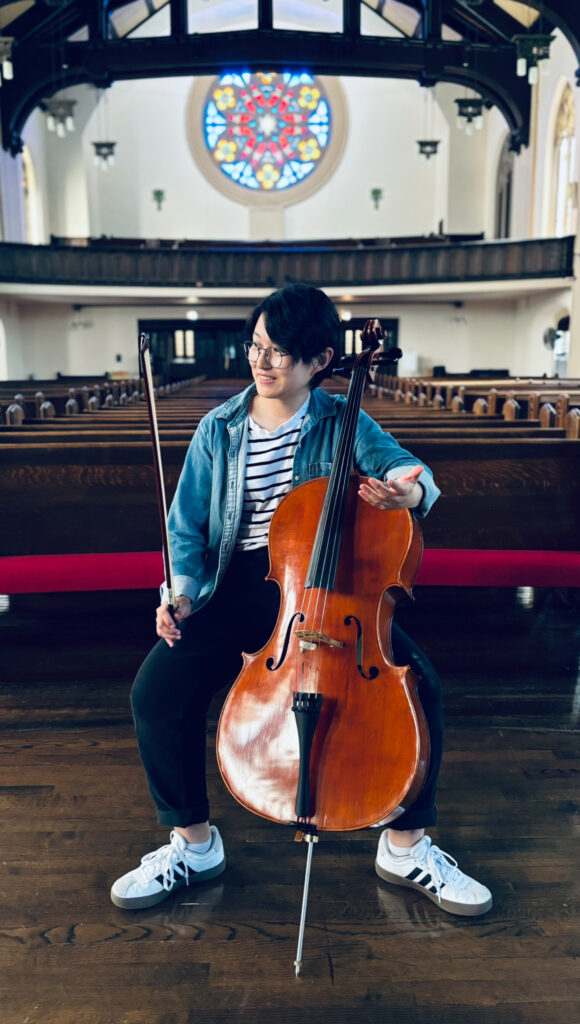An Enduring Narrative
Part 2 of 2 on the LA Phil’s Seoul Festival
(read Part 1 by ioana istrate)
By Mi Ran Choi
Senior Contributor, Hollywoodland News
In continued collaboration with Hollywoodland News’ Regina Jordan, I was invited along with my good friend, violist and educator Ioana Istrate, to experience part of the LA Phil’s Seoul Festival – a celebration of the music and artistry of South Korea and the Korean diaspora.
Whether your first thoughts at the mention of “Korea” are of vibrant K-Pop idols, or of testing the limits (both yours and the restaurant’s) of all-you-can-eat Korean BBQ, there is no denying of the wide reach of Korean culture – especially in Los Angeles, home to the largest population of Koreans outside of the motherland.
This is part two of our two-fer coverage on an evening of Korean Premieres and Sunwook Kim at the Walt Disney Concert Hall and words can hardly convey the brilliance we experienced that evening. Our excited squeals before the concert probably came the closest.
As a second-generation Korean American, I am truly thrilled to see efforts such as this festival being curated, amplifying the voices of contemporary Korean artists and broadening public understanding of the multiplicities of Korea’s ever-evolving culture!
Gyopo – An Evolving Definition
On a serious note, I couldn’t help but notice that the timing of the LA Phil’s Seoul Festival comes shortly before the 75th anniversary of the outbreak of the Korean War (June 25,1950).
It wasn’t so long ago since three years of devastating war divided families and a nation freshly liberated from Japanese annexation and cultural genocide. A fragile peace fell over the bisected peninsula with the 1953 Korean Armistice Agreement, and a large diasporic population scattered worldwide – most notably in Los Angeles.
Growing up in LA decades removed from these events, a loaded term I’ve heard thrown around a lot is gyopo (교포), usually with a negative undertone to mean “an ethnic Korean who has lost touch with their roots.” My parents had at times used the term to describe acquaintances so eager to be considered “American” that they assimilated by outright erasing their Koreanness in every way possible. Such descriptions always came with tastes of undue judgement, and unnecessary divisiveness for an already divided demographic.
Much to my chagrin, I was also frustratingly labeled with this term by family and others for my “Americanized” ways and education, even though Korean was my first language and I was raised with Korean food, music, and values. Thanks to the term gyopo, I felt to an extent (and still feel to this day) that I needed to prove my Korean identity to myself and others – perhaps by going as far as replacing my blood with runny gochujang for what it’s worth.
All this being said, you can probably imagine my initial confusion, but eventual refreshment at seeing a nonprofit organization named GYOPO collaborating with the LA Phil’s Seoul Festival. Reading notes about the organization’s neutral redefinition of gyopo (“someone of Korean heritage born or raised outside of the country”*) and their mission to amplify marginalized voices of Korean artists quickly replaced my doubts with feelings of hope. Their work is a much-needed change of pace in the face of South Korea’s stance of “continued nationalism, ethnic essentialism, and queerphobia.”*
Seeing the diverse lineup of artists collaborating in the Seoul Festival, from video installation artists, queer performing artists, and musicians was a real treat, and is an encouraging sign of openness blooming in Korean communities at home and abroad. I highly encourage you, dear readers, to check out the LA Phil’s pages on the festival for a better description of GYOPO’s impact and more in-depth profiles on the collaborating artists.
* Quoted from author and curator Alex Paik’s “A Polyphonic Identity,” included in the evening’s program booklet.
Contexts: Traditional Idioms and H’on
Let’s put it this way: Having written my master’s thesis on (and nerding out over) the work of Korean-German composer Isang Yun and his contributions to contemporary Korean music, to say that I was excited for the La Phil’s Seoul Festival is an understatement.
No, I was FULLY in my element – jittering in my seat alongside Ioana who was in a similar boat for the upcoming viola concerto. Her article on LA Phil’s Seoul Festival does a fabulous job capturing our mutual enthusiasm and observations by piece, so if you haven’t already, I encourage you to please check it out! What I’d like to briefly look at with you all is the contexts for these pieces.
The title of the second piece in the program, Kay Kyurim Rhie’s (b. 1971) H’on (혼), served as the overarching theme of the evening. The term is difficult to translate into just one word, as it encapsulates an intangible spirit of strength and resilience, enduring through generations.
The way that each composer – and in the case of the Brahms (1833-1897) Piano Concerto, soloist – embodied H’on in their work was a privilege to experience.
Percussion plays a critical role in traditional Korean music, found in celebrations among common folk, or in refined court ensemble performances. Rhie’s H’on, along with Sunghyun Lee’s (b. 1995) Clockworks and Fireworks, and Texu Kim’s (b. 1980) Viola Concerto “Ko-Oh” all make brilliant use of layering the orchestra to really make the percussion stand out from the overall texture.
What caught my attention was traditionally-styled manipulation of main pitches or what composer Isang Yun refers to as Haupttöne. These would be built or played upon by ornamentations (sigimsae) ranging from vibrato (wider than normal vibrato from Western contexts), to scoops and embellishments before returning to the Haupttöne. A listening exercise for the first three pieces in the program was identifying what composers chose as their home base for executing their masterfully-crafted ornamentations.
A Lullaby to a Weary People
Is there a melody or song that instantly brings comfort and safety to mind for you?
The audiophile in me would respond with Debussy’s Ballade, L.70. But if we really wanted to dig deeper, for me it would go back as far as the lullabies my grandmother and mom comforted me with, whenever I’d wake up from night terrors.
Jajang, jajang, uri aegi (Sleep, sleep, our baby)
Jajang, jajang, uri aegi
Kko-kko dak-ah, uji mara (Don’t cluck, chickens)
Uri aegi jam-eul kkel-la (Our baby might wake up)…
The frenetic pacing of the second movement of Kim’s Viola Concerto as part of the LA Phil’s Seoul Festival, seemingly alluding to modern-day Korea’s “ppalli-ppalli” (hurry hurry) culture and showcasing the limits of the technical possibilities on the viola, set the stage well for hushing into the third movement’s lullaby motif.
With the melodic refrain written for the middle-lower register of the viola’s range, it sounded pretty close to the range of a mother’s voice, softly yet soulfully comforting their little one back to the safety of their dreams. There were even variations on the lullaby, reminiscent of my mom’s unique ad-libs when it became apparent that mini-Mi had no intention of going back to sleep anytime soon. The piece faded off with a soothing, yet haunting solo passage for the viola – reiterating the lullaby theme one more time before disappearing into silence.
Sunwook Kim, A Trailblazer in Asian Representation
On Sunwook Kim’s stellar performance with Brahms’ Piano Concerto No. 1 in d minor, Op. 15, I want to highlight that this was the piece he performed when winning the prestigious Leeds International Piano Competition in 2006. At the time, he was the youngest competitor to win in 40 years, AND the first Asian winner.
In the US, Asian Americans can carry the reputation of being the “model minority” or “unknown peril,” depending on who you ask. In 1967, Time Magazine even penciled us Asian musicians as a threat to the western musical world’s sophistication.
Times have thankfully changed where there is warming inclusivity in leading ensembles and representation in classical music competitions, but a glass ceiling remains ever-present.*
It is representation from artists like Kim that help to dismantle the glass ceiling and established stereotypes, panel by panel, and help to broaden the public’s multidimensional awareness of the many brilliant Asian American artists out there.
*For more in-depth discussion on this topic, I highly recommend checking out the New York Times’ article “Asians Are Represented in Classical Music. But Are They Seen?”
Taegeuk – Balance at the LA Phil’s Seoul Festival
This was an evening of musical balance, of references old and new. If you’re still reading this lengthy reflection, I would like to conclude this piece with this note.
To be able to attend part of the Seoul Festival at a world-class performance venue in the heart of Los Angeles, celebrating and honoring our Korean guests and immigrant community was a true privilege.
It wasn’t just the music that lingered with us after the show—it was what we learned was unfolding just blocks away. Ioana and I didn’t know this yet, but just half a mile away by City Hall that same evening was the beginning of the ongoing June 2025 protests. The initially peaceful protest that evening was in response to ICE raids affecting the LA Fashion district, an area known for its Latine and Asian immigrant communities and businesses, along with a clothing store and a Home Depot in other parts of the city. Innocent families are being violently interrupted and torn apart with arrests and threats of looming deportation.
Reflecting on this dissonant, simultaneous occurrence days later, and witnessing the California National Guard and deployment of the Marines in response to people exercising their rights to assemble and protest peacefully – in a designated sanctuary city at that! –
I urge our readers, local or distant, to stay informed and safe, and to please stand up to help our affected communities as you are able.
Should you find yourself at LA’s Music Center or Gloria Molina Grand Park, both have shared public statements, pledging their commitment to keeping these spaces safe and welcoming for all to peacefully exercise our First Amendment rights. Let us honor, in whatever ways we can, the beautiful diversity and H’on of our communities with dialogue and action. It’s in these moments of contrast—where music echoes in one direction and marching feet in another—that we’re reminded why representation, truth-telling, and community matter so much.
About the Author:
Mi Ran Choi

East Hollywood-native Mi Ran Choi (they/she) is a cellist and educator primarily based in Chicago. They hold a Bachelor of Music in Cello Performance and a Certificate in Music for Social Change and Human Values from North Park University, and a Master of Arts in Applied Music Pedagogy from Northeastern Illinois University.
Choi is an active chamber musician, collaborating regularly with their husband, organist and pianist Nguyễn “Bobby” Trần Xuân Nguyên as well as the Wander Ensemble chamber music collective.
Since July 2024, Choi (temporarily) returned to their hometown and now serves as an Alpert Scholar Coordinator with Los Angeles City College’s Herb Alpert Music Center, coaching chamber music ensembles and aiding the Philharmonic Choir director.
In their spare time, they enjoy composing, writing, and reading—if not fueling their shameless coffee addiction, which they document on their site cello-there.com.


Leave a Reply